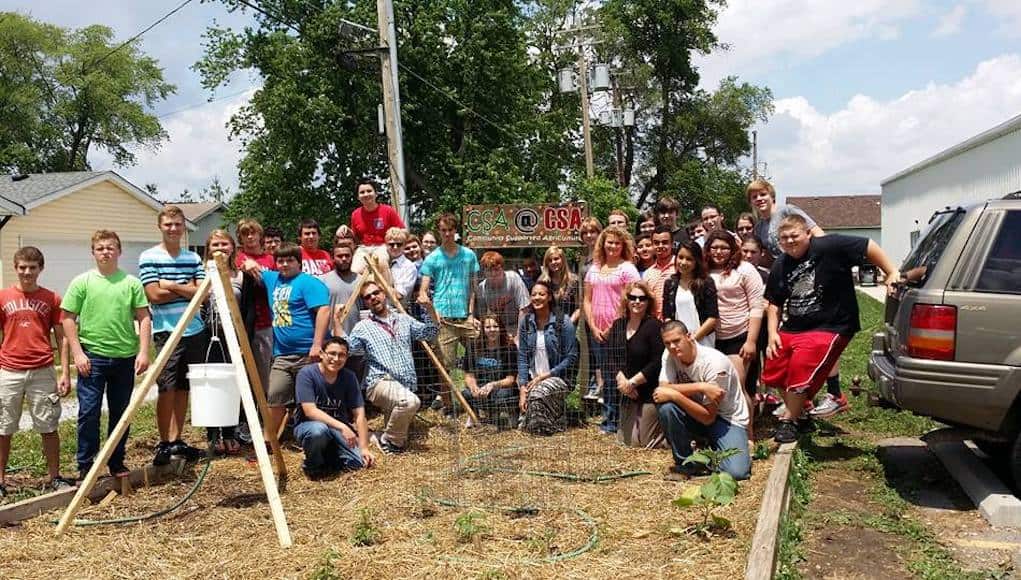Every School Needs a Garden

When was the last time you asked your students to imagine the possibilities of the space you share with them at school? What if they were given the time, tools, and money to make their visions happen? Would they want to keep coming back?
I know lots of teachers provide authentic learning experiences that ask students to dream big. And more would, if the curriculum allowed it. But maybe the curriculum does, in fact, allow it.

When our school, Columbus Signature Academy New Tech High School opened in 2008, we knew we wanted a garden. We also knew that at the time, there was no garden. I am not sure whether or not Place-Based Education was a term that existed back then or that we knew we were doing it. Sustainability was not an everyday phrase as it is today. All we knew was that it just made sense, at a Project-Based Learning school, to have a garden and to teach students how to grow their own food.
Since then, I have come to believe quite ardently that growing food is as important a life skill as managing money, maintaining a car, or successfully interviewing for a job; and doing this, at school, through the act of tending a garden is a perfectly perfect way to teach sustainability and use one’s own place to allow rich learning experiences to occur.

At first I didn’t fully appreciate our garden. I did not appreciate the fact that it would become such a story that would unfold over many years, having been told through the imaginations and visions of so many students. The first iteration of the garden was a dozen boxes, built from donated lumber, assembled by a parent volunteer, and filled with compost from another parent volunteer (an employee of the recycling center who drove a front loader all the way across town with a scoop of compost for us). We started simply, growing sure- thing crops like lettuce and carrots and I will always cherish the memory of eating a communal salad, all from the same giant bowl, with my small (and proud) biology class. From the very start, we were building community through our garden.![IMG_2589[1].JPG](http://gettingsmart.wpengine.com/wp-content/uploads/2017/10/0a2e200c-2ba9-49f9-abce-d48f4d171615_IMG_25895B15D.jpg)
The garden also presented numerous design challenges. When it became time to expand, a handful of students put in extra hours assembling landscaping timbers into the garden’s current formation. We went into it not knowing the best way to do it, but together, teachers and students figured it out.
One major design challenge: no access to water. From hauling buckets to borrowing water from a neighbor, our garden presented us with a truly authentic problem (which naturally led us to a project). Our Geo-IED (integrated Geometry and Introduction to Engineering and Design) students worked with our corporation’s Head of Facilities and Maintenance to figure out a way to get rainwater from the roof of our building over to our garden.
When it was clear that they had “hit a wall” and that this wouldn’t work, they found a workaround: build a shed and capture rainwater from its roof. But sheds cost money. Our grade 9 Global Science Perspectives (integrated English and Environmental Studies) students wrote a grant that was approved and fully funded the building materials for a shed. Currently, rainwater is collected from the shed’s roof into a 1,000-gallon reservoir, from which drip irrigation lines deliver water to garden plants. Suffice it to say that the garden has provided many, many authentic challenges for us to solve together.
 Naturally, all of these “spontaneous” challenges helped students uncover academic standards from trigonometry and trusses (Geometry and Engineering), technical writing (English 9), to measurement and unit conversion (math and science). Though the original reason for building the garden, was to teach students to grow food!
Naturally, all of these “spontaneous” challenges helped students uncover academic standards from trigonometry and trusses (Geometry and Engineering), technical writing (English 9), to measurement and unit conversion (math and science). Though the original reason for building the garden, was to teach students to grow food!
Each year, we have projects in at least two classes (Global Science Perspectives and Biology) that directly grow food in both fall and spring. In GSP, we focus on some of the more societal issues such as food security, sustainability, and the health impacts of whole vs. processed foods. In Biology, we focus on photosynthesis, nutrient cycles, and symbiotic relationships. Throughout the year, even when there is not an active garden project, there are students who do routine garden maintenance, start seeds indoors, and plan for the future.
![IMG_2621[1].JPG](http://gettingsmart.wpengine.com/wp-content/uploads/2017/10/eb6360b1-dbc0-4369-816a-86e343753df7_IMG_26215B15D.jpg) Students always have a voice in what is planted, how the garden will be cared for, and what will happen with the food. In years past we have given the food to our school families, the neighborhood surrounding the school, and have fed it to students in the school cafeteria.
Students always have a voice in what is planted, how the garden will be cared for, and what will happen with the food. In years past we have given the food to our school families, the neighborhood surrounding the school, and have fed it to students in the school cafeteria.

There have been plant sales and canning sessions in our school kitchen and cooking clinics out by the picnic table. Our local county extension educator also offers tours and workshops at the garden. We have also added a small orchard of fruit trees that are producing pears and cherries.
The garden has taught us all a great deal, and not the least myself. I have learned firsthand how merciless weeds will consume a garden over the summer if allowed to. I have become better at balancing the facilitation role associated with gardening as well; while all students will learn to weed, water, and thin, I will advise strongly on certain other matters, like choosing a crop that is seasonally appropriate, and give kids freedom on others, such as allowing plants to climb up a trellis or spread out like a vine.
That initial intuition that having a garden would be a good idea has been confirmed now by a decade’s worth of students that have gardening skills. Whenever I am tagged by a former student on social media on a post about how “Every school should have a garden,” I swell with pride. It turned out to be one of those ideas that truly took on a life of its own. Every school should have a garden.
For more, see:
- Want Authentic PBL? Take Students to the Farm
- What is Place-Based Education, and Why Does it Matter?
- Infographic | The Potential of Place-Based Education
Stay in-the-know with all things EdTech and innovations in learning by signing up to receive the weekly Smart Update. This post includes mentions of a Getting Smart partner. For a full list of partners, affiliate organizations and all other disclosures, please see our Partner page.








0 Comments
Leave a Comment
Your email address will not be published. All fields are required.